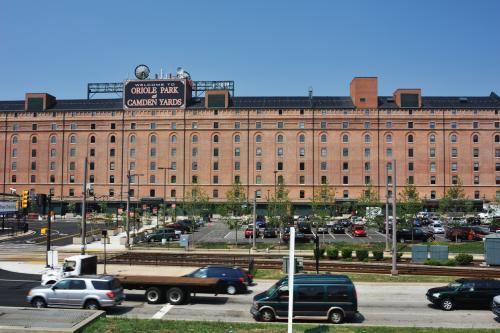
According to new research conducted by Department of Government and Politics Professor and Center for Democracy and Civic Engagement (CDCE) Research Director Mike Hanmer—along with colleagues at four other universities in partnership with the Civic Responsibility Project (CRP)—Americans support sports stadiums becoming another place where individuals can go to cast their vote; a change introduced in 2020 due to the COVID-19 pandemic.
“The results show that there is widespread support for using stadiums and arenas for voting. Teams, election officials, and voters all expressed a great deal of enthusiasm,” said Hanmer, who was asked to participate in this research project by co-contributor Tova Wang, a voting rights expert and Senior Practice Fellow in American Democracy for the Harvard Kennedy School’s Ash Center for Democratic Governance and Innovation.
The five-university research team interviewed franchise officials and election administrators to extract qualitative insights about facilities’ efforts and impact, and also conducted an online, national survey of more than 2,100 individuals from March 22-29, 2022.
When asked, “Do you support or oppose using sports stadiums as polling places for voting?” 77% of respondents to the survey said they “strongly” or “somewhat” supported voting at stadiums.
However, it is important to note that according to the data, an increase in stadium voting should not necessarily lead to a decrease in the number of smaller, local polling places available to individuals. Three of the “very” or “somewhat” important reasons selected by those who said they opposed stadium voting were that “Not every community can benefit,” “Voting should be local” and “Stadium voting will divert resources from traditional polling places.”
In addition, overall, proximity to the stadium was a good predictor of whether someone would vote there. In one case study of Washington, D.C.’s National’s Park—the Atlanta Hawks’ State Farm Arena, the Charlotte Hornets’ Spectrum Center, Los Angeles Dodgers’ Dodger Stadium, and the Indianapolis Colts’ Lucas Oil Stadium also served as case studies—18% of in-person voters who lived within 2.5 miles of the Washington Nationals’ home voted there, but just 1% of those who lived more than 2.5 miles away did so.
Researchers also found that those who voted in a stadium were able to take advantage of perks that might entice future voters to flock there as well. Stadium wait times were often significantly shorter than the average wait times at other local polling locations; more than eight times shorter at the State Farm Arena, where the average wait time was 26 minutes, than some other county locations, where the average wait time was four hours.
Stadium locations also provided access to entertainment, team swag, photo opportunities outside of the voting booth, and help from stadium employees with ample customer service experience, perks that the report authors suspect created a better voter experience and could be utilized in the future to potentially increase turnout.
“This work was a natural extension of the sports and politics survey work CDCE recently conducted with Mark Hyman, Director of the Shirley Povich Center for Sports Journalism, and The Washington Post,” Hanmer continued. “Mark helped us make important connections with a number of major league teams that participated in the research."
One such connection was to Greg Bader, the Baltimore Orioles’ Senior Vice President of Administration and Experience. Oriole Park at Camden Yards, home of the Baltimore Orioles, served as a polling place in 2020.
“It is important that every American has the ability to cast their vote, as that is the foundation of our democracy,” said Bader. “Our ballpark is conveniently located in the heart of downtown, and being able to provide that ease of access to our community was of utmost importance to encourage participation; and one we hope to continue to offer in the future.”
“I'm also hopeful that going forward stadiums and arenas will be intentionally designed so that they can provide large, open, accessible, and secure spaces that can be used for voting and other civic activities,” Hanmer added.
The research team consisted of scholars from Columbia University, Harvard University, Rice University, and Temple University. UMD graduate students Michael Dunphy, GVPT ’21, who is pursuing an M.S. in Applied Political Analytics, and Ted Ellsworth, a Ph.D. candidate, provided research assistance. Research was published by the CRP, in partnership with the Center for Election Innovation and Research and the Civic Alliance, and was administered by Temple University.
To read the CRP’s press release, visit go.umd.edu/crppr. To read the executive summary visit go.umd.edu/stadiumresearchexecsummary.
Photo by iStock.
